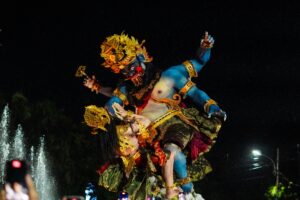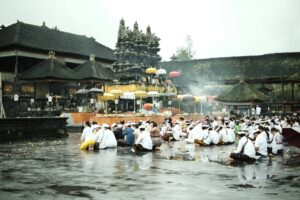To truly understand Bali, you must understand its unique perception of time. This is governed by the intricate and fascinating Balinese calendar systems. Have you ever wondered why major Balinese holidays fall on different dates each year? The answer lies not in one calendar, but in two. They run in parallel to create the rich, cyclical rhythm of island life.
Unlike the single Gregorian calendar, Balinese life is organized by two distinct systems. These are the lunar-based Saka calendar and the complex, 210-day Pawukon calendar. Understanding these two calendars is like unlocking one of Bali’s most beautiful secrets. As your friendly hosts at Merusaka Nusa Dua, we want to guide you. We will show you the unique ways time is measured in Bali.
The Saka Calendar: The Lunar Year & The Day of Silence
The Saka calendar will feel more familiar to visitors. It is based on the cycles of the moon. It also roughly follows the length of a solar year.

- How it Works: The Saka calendar consists of twelve months. Each month has 29 or 30 days. This results in a year of about 354 days. To keep it in sync with the solar year, an extra month is added every 30 months. The Saka era began in 78 AD. Therefore, the Saka year is 78 years behind the Gregorian calendar. For example, 2025 AD is the Saka year 1947.
- Its Main Purpose: The most important function of the Saka calendar is to determine the date of Nyepi. This is Bali’s most unique holiday. It is also known as the Day of Silence. This island-wide day of quiet and self-reflection is always held on the day after the new moon of the ninth month.
The Pawukon Calendar: The 210-Day Ritual Cycle
This is where time in Bali becomes truly unique and fascinating. The Pawukon calendar is a complex ritual calendar. It is not based on any astronomical events. Instead, it governs the auspicious timing of nearly every ritual and ceremony on the island.
- How it Works (The Simple Version): The Pawukon system is a 210-day cycle. It is created by the alignment of ten different “weeks” that run at the same time. These “weeks” have different lengths, from a one-day week up to a ten-day week. A particular day’s character and auspiciousness are determined by which days from these different weekly cycles happen to fall on it.

- Its Main Purpose: This calendar determines the dates for most of Bali’s major religious ceremonies. This includes the island’s most important festival, Galungan. It celebrates the victory of dharma (good) over adharma (evil). It also includes Kuningan, and the thousands of temple anniversary festivals known as odalan.
- Why the Dates “Float”: The Pawukon cycle is only 210 days long. This is roughly seven months in the Gregorian calendar. Therefore, its holidays do not align with our 365-day year. This is why Galungan and other Pawukon-based ceremonies appear to “float” through our calendar. They occur twice a year. Their dates shift each time.
What Does This Mean for a Visitor?
So, how does this ancient system of timekeeping affect your holiday in Bali? In many wonderful ways.
- A Living, Breathing Culture: These calendars are the engine of Balinese culture. They ensure the island has a vibrant and continuous cycle of ceremonies. This is why there is always something beautiful and sacred happening somewhere in Bali.
- Planning Your Trip: Do you want to witness a specific major ceremony? You should check the dates for the year you plan to travel. Examples include the vibrant street decorations of Galungan or the unique stillness of Nyepi. The dates will be different each year.
- Everyday Life: Don’t worry about confusion for your daily plans! For all modern purposes, the standard Gregorian calendar is used everywhere. This includes hotel bookings, flights, and restaurant reservations.
Conclusion: A Deeper Appreciation
The dual Balinese calendar systems are beautiful and harmonious. They organize life around ritual, community, and auspicious timing. While complex, a basic understanding of this system offers visitors a much deeper appreciation for Bali’s cultural richness. It also reveals the spiritual rhythm that makes the Island of the Gods so truly unique.



